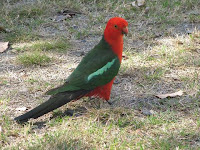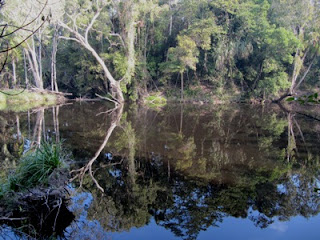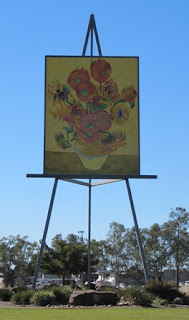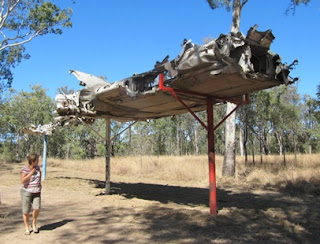Monday 12 August
We departed Carnarvon Gorge headed north then east, stopping briefly at Rolleston (again) and Bauhinia, before finding an excellent free camp on the Dawson River, just short of Moura.
Day 86 was a Tuesday and we were soon in Biloela, quite a sizable town with a newish Woolworth shopping centre. After an excellent coffee we did some shopping and were back on the road, arriving at Cania Gorge around lunch time.
 We set up camp and had a sandwich for lunch in the shade of a tree—only to be swamped by heaps of parrots of varying sizes, colours and breeds. It was hard work to prevent theft of our lunch.
We set up camp and had a sandwich for lunch in the shade of a tree—only to be swamped by heaps of parrots of varying sizes, colours and breeds. It was hard work to prevent theft of our lunch.
We arranged delivery of a half 44 gallon drum for a fire and soon had a roaring fire—although the wood did not burn as hot as some of the fires earlier in our trip. Maybe I missed Darryl’s adept skills. Our new BBQ plate came out and was christened with a piece of chicken. It was good.
 .
.
 |
| Bettong |
.
We were visited by a few Bettongs—a local marsupial. There were about knee high, and could move very fast when they wanted to.
.
Wednesday 14th was walking day so we tackled the walks to the Fern Tree Pool, the Giant’s Chair Lookout and the Big Foot. The walk was not as good as Carnarvon but good exercise just the same. The following photos give you an idea of what we found on the 6km walk.
 |
| Giants Chair Lookout |
After lunch we went for a short drive to Cania Dam and some more excellent scenery (see below).
The fire was relit and this time a mixture of porterhouse steak and pork shops were cooked, to accompany the potatoes and pumpkin in the coals (wrapped in foil of course). A fine red was used to wash it all down.
The agenda for Thursday was the same—more walking. This time we visited Dripping Rock, The Overhang, Dragon Cave, Bloodwood Cave and the Gorge Lookout. This was another 6 km.
 |
| Bloodwood Cave |
 |
| The Overhang |
 |
| Some Lovely Colours |
 |
| Jane on a swing looking for her Tarzan |
Shirley had a swing on a thick vine.
Again the fire was lit and this time a mixture of sausages, potatoes and pumpkin were cooked.
Friday was a quiet day with minimal walking on the agenda. However I did take advantage of my tripod to get the following photo from a corner of the caravan park. Not a bad view.
 |
| View from Cania Gorge Caravan Park |
Dinner was fish and chips, cooked by the caravan park, and was eaten in front of our fourth camp fire in four days. All of our wood was not gone, even the wood I collected at Bunnings in Alice Springs (a long time ago). We also spent some time talking to neighbours who live in Gippsland.
On Saturday we packed up and hit the road again.
 Our first stop was at Eidsvold, where we checked out the Australian Bush Learning Centre—a place dedicated to the memory and work of R M Williams, the legendary stockman, leather both and clothes maker and all-round great Aussie bloke. It was well work the effort
Our first stop was at Eidsvold, where we checked out the Australian Bush Learning Centre—a place dedicated to the memory and work of R M Williams, the legendary stockman, leather both and clothes maker and all-round great Aussie bloke. It was well work the effort
We then stopped at Gayndah (don’t ask me where these names come from) at the Big Orange to buy some (wait for it) oranges, mandarins and avocados.

We seemed to have passed the coal country and were in country that alternated between cattle, grain crops and woodlands—with a bit of citrus for a change. There was a lot of loose water and plenty of evidence of the recent floods—with many tress being unnaturally horizontal. Many creeks, rivers and gullies were clogged with fallen trees.
We moved passed Biggenden and arrived at Childers, lovely middle sized town with plenty of recent restoration work being evident and preservation of historical buildings an sites. It is a lovely town. We free camped just north of Childers at a place called Apple Tree Creek. It just so happened that Apple Tree Creek had a pub called the Apple Tree Creek pub, and (guess what) we dined there. The chicken parma was pretty good.
 |
| Apple Tree Creek Hotel |
Sunday 18th saw us head into Hervey Bay and set up camp at the Torquay Beachside Caravan Park, just a mere 30 metres from the beach. Shirley was delighted—there was a shoe shop within 200 metres. I was delighted, there was an Irish pub 700 metres away.
The sunset had to be seen to be believed, with the following (poor) photo being taken about 50 metres from the caravan—and interrupting happy hour.
 |
| Torquay Pier (Hervey Bay) |
I started Monday with a 5 km walk along the superb beach among threatening clouds. It was a slow day with some shopping and some reading (and an afternoon snooze). Our shopping including some fresh prawns, scallops and calamari which were cooked on the BBQ and served with salad, for dinner.
 |
| Fraser Island |
Fraser Island was the theme for Tuesday. We were picked by our guide, Gerard, at 7:30 am and soon learned that he is also a grain farmer from Victoria (Wangaratta) whose picture is on the front of the Uncle Toby’s Oats packet. We moved from the bus to the ferry for the ride to Fraser Island, then to a serious 4WD 20 seater bus.
We then embarked on the 4WD journey of our life as Fraser Island is the largest sand island on the world. Although it has no grass lands it is heavily populated with lots of magnificent timber. After a couple of stops we turned left onto the beach along the east coast. This beach is a gazetted Queensland highway and is often subjected to the boys in blue doing alcohol and drug tests. It is a busy place for 4WD lovers, fisherman and light planes—who have to give way to cars. How would you care to test that law?
 |
| Dingo on the beach |
In the timber logging days the trains ran on wooden tracks, made from trees from the island. Where else has that happened?
 |
| Wheels to run on wooden tracks |
As it has no grasslands and few eucalypts it has no kangaroos or koalas. However it has a population of pure dingoes, monitors (goannas), snakes and birds. We were happy to miss out on the snakes but saw examples of the others.
I should also mention that Fraser Island has beaches that compare favourably with any other, ditto for the sea water and the purest fresh water.
 |
| Monitor (or Goanna, if you like) |
It was a memorable day on a remarkable island. It was capped off with some great sunset views on the ferry home.
Day 94 was a quiet day with the two main activities being to wash and vacuum and very dirty car and have a goodbye dinner with John and Fay, as the ’morrow will see us head in different directions.
Thursday 22nd saw us depart Hervey Bay and head to Maryborough which is noted for three key points (among a few others), as follows:
a. It was the birth place of a lady called Helen Lyndon Goff who used the pseudonym of PL Travers to write the Mary Poppins series of books.
b. It has a large number of marvellous 1860-1890 era buildings that have been restored and still used for various purposes.
c. It has a street market every Thursday morning.
We visited the Brennan and Geraghty Store Museum which when it closed in 1972 was a grocery and general store. The owner (93 year old Mr Geraghty) just closed the doors and left 99% of the stock on the shelves, some of the stock dating back to the late 1800’s.
 |
| Brennan & Geraghty Store Museum |
It is a museum that has not included any pieces from outside the museum—all the pieces are what was in the shop when it closed. There are only two other similar museums in the world. The stock includes Brasso, Rinso soap powder, Bex powers, spices and the sort of stuff you would find in a pre-supermarket grocery store.
In the pre 1890's depression days they sold farm supplies, house hardware supplies, machinery, alcohol, firearms and ammunition, plus heaps of other stuff).
We then drove another 70 km and camped at a place called Tin Can Bay, which apparently gets its name from the indigenous word ‘Tuncunbar’ thought to refer to the dugongs that frequent the inlet.
 |
| Scribbly Gum |
Rainbow Beach was originally called Back Beach until someone discovered the 70+ colours in the sand and initiated a name change.
So on Friday we went for a drive to check it out.
The first item of note was a scribbly gum tree, so called because of the marks the scribbly gum moth larvae makes as it traces the insect’s life cycle. Very interesting patterns. Our next spot was the magnificent views from Carlo Sand Blow, overlooking Rainbow Beach.
 |
| Carlo Sand Blow - Rainbow Beach |
 |
| Rainbow Beach Bay |
We grabbed a pie for lunch and continued more sightseeing—including the horizontal plant in the adjacent photo.

Rainbow Beach has a small shopping centre with everything you would need for a relaxing week or so.
Back in Tin Can Bay we booked in to the Marina Bar & Grill for dinner and had an excellent meal overlooking the water.
Saturday 24th was a relaxing day with a couple of walks and plenty of book reading time. We enjoyed the following view of Tin Can Bay.
 |
| Tin Can Bay |
Sunday and day 98 was the day to head home. So we packed up and departed Tin Can Bay and started on the 1850 km to Eltham. Our first stop was Gympie, a very old and historic town, where we refuelled to the tune of 163 litres (the 40 cent off voucher helped). We then meandered across to Kingaroy which is famous for its peanuts and pumpkin scones. However we did not see any peanuts and we have had plenty of scones lately. So we had lunch and pressed on.
 |
| Moonie Oil Pump |
We had an ice cream at Dalby which seems to be a very nice medium sided town. But our agenda was “move” - and so we did. After 420 or so km we arrived at Moonie and decided to camp. We were rather disappointed that there had not been any suitable free camps along the road. Moonie is a very small town and is known for two main things:
1. It is the location of the first oil strike in Australia, circa 1964, and the well is still providing its black gold, but in a much reduced volume. The pump in the photo was the first pump used at Moonie and it was powered by the gas that came from the oil well.
 |
| 37 kg Ferrel Boar |
2. Moonie has the largest ferrel pig display in Australia, with a number of local beasts mounted on the wall of the pub.
Incidentally the pub, motel, service station, and caravan park are all one enterprise and make up 90% of the business enterprises in Moonie. The enterprise is location on the cross roads of two busy highways and gets east-west and north-south customers.
 Another interesting thing about the Moonie district is the problem with prickly pear. It apparently arrived with the First Fleet when Captain Arthur Phillip brought plants from Brazil and they were introduced for stock fodder in the Parramatta district in the early 1800's—and later to mid QLD. By 1925 prickly pear was estimated to have spread over 25 million hectares and spreading at a rate of over one thousand hectares per day.
Another interesting thing about the Moonie district is the problem with prickly pear. It apparently arrived with the First Fleet when Captain Arthur Phillip brought plants from Brazil and they were introduced for stock fodder in the Parramatta district in the early 1800's—and later to mid QLD. By 1925 prickly pear was estimated to have spread over 25 million hectares and spreading at a rate of over one thousand hectares per day.
After much research the Cactoblastis moth from South America in was introduced in 1926. Many prickly pear populate the side of the road.
We awoke early and hot the road. Goondiwindi was our first (coffee) stop. It is well known for its famous horse (Gunsynd) and growing cotton. We then crossed the river and moved into NSW. Moree was the next stop and a good place for a stroll. We then pressed on to Narrabri and had lunch in the park.
I was in a good mood so I let Shirley drive, while I admired the scenery and counted the different crops, such as wheat, cotton, smorgon and canola. The variation in colours made for a pretty drive. The following photo has the Kaputar National Park in the background.
We again could not find a decent free camp so we stopped at the John Oxley Park in Coonabarabran.
Those of you who know me well know that I am an active fan of the Aussie call “cooee”, usually used with many more “o”s and “e”s. Our first stop today made me aware of one of the important uses of the call. In 1915 when things were not to flash in places like Gallipoli recruitment was very hard so a group of 35 coves set off from Gilgandra (our first stop for today) to walk to Sydney (a mere stroll of 766 km). Their use of the call “cooee” caused the group of volunteers to grow to 277 men by the time they reached old Sydney town. They were called the "cooee boys". That achievement had world wide (allied) recognition and is still celebrated today. It makes you proud to be an Aussie. It is even more significant when you realise that they followed the lead of King George and “swore off the booze until the war ended”.
Our subsequent walk around Dubbo was subdued after that, not to mention the mess up (I could have used stronger terms) when I put 159 litres of diesel in the car and the guy after me added to my bill (computer malfunction of course). As I said above “those of you who know me” know that it all worked out fine. Even the boys in blue (getting fuel) were chatty and advised the best road home (they went north, we went south).
We had a look around Parkes and camped for the night at Forbes. My curried snags and mash were to die for (bit hot for Shirley). Of course the caravan did not smell too flash.
Wednesday was our penultimate day (whatever that means). We departed Forbes and stopped at West Wyalong for a cuppa (while thinking of friends who bought crook fuel here recently and were stranded for some time). We then pressed onto Wagga Wagga by lunch time and could not find a park anywhere near food shops (as in a pie shop), so we moved along and found a great bakery/coffee shop at Uranquinty, just 10 km away.
We stopped for the night at Wodonga and found a great tavern (I love that word) just 300 metres away. We have been driving for two days (around 700 km) through lovely country that is heavily sewn with grain and canola crops. The constant contrasts in greens and yellow is illustrated in the photo above.
On Thursday 29th August 2013 we drive the final leg from Wodonga to home. It was day 102 and we had completed around 16200 km.
.
***** End of this posting ****
A wrap-up summary will be the final posting.

















































